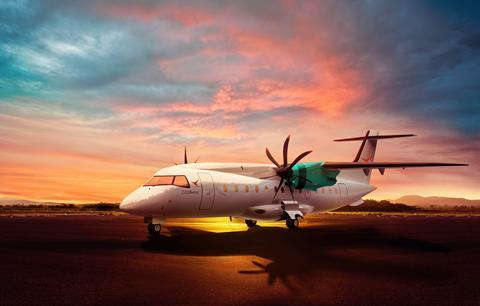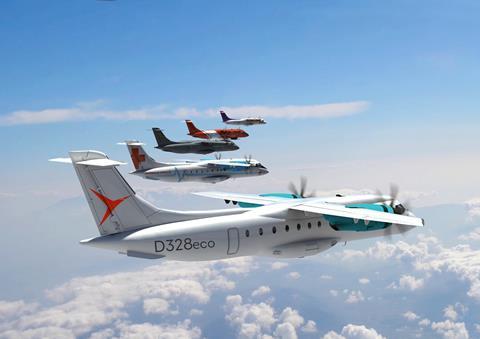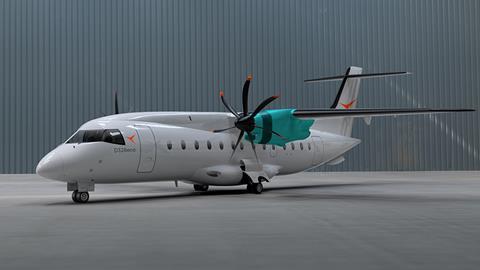Of all the schemes designed to take advantage of a potential resurgence in regional aviation demand, the revival of the Dornier 328 twin-turboprop is one of the more curious.
Now billed as the D328eco, manufacturer Deutsche Aircraft – a sister company of type certificate holder 328 Support Services – plans to modernize the legacy type with new engines and avionics, while a 2.1m stretch of the fuselage will raise accommodation to 43 passengers, an increase of 10 over the previous maximum.

If all goes to plan, certification and service entry will be achieved in 2025, at which point new aircraft will be rolling off a purpose-built final assembly line at Leipzig/Halle airport.
The update of the turboprop is, on paper at least, relatively straightforward. New Pratt & Whitney Canada PW127S engines will replace the PW119Cs of the earlier 328-100, raising maximum take-off power on each powerplant to around 2,750shp at 1,200rpm, from 2,180shp at 1,300rpm. The longer fuselage, additional payload and marginally heavier engines combine to increase maximum take-off weight by 1,700kg (3,750lb) to 15.6t – the same as the legacy jet-powered 328-300. Two other key changes are also planned: a new digital avionics suite which is “designed for future single-pilot operation”; and fuel tanks which will be compatible with 100% sustainable aviation fuel (SAF).
These changes, says Deutsche Aircraft managing director Dave Jackson, will be incorporated via an amendment to the current type certificate, rather than approval for an all-new aircraft; a quicker and lower-risk route to market.
However, Jackson is quick to reject accusations that the new aircraft is simply old technology with the addition of the latest-generation engines.
“It is a completely different proposition in terms of the product,” he says, noting that both the Airbus A320neo and Boeing 737 Max are older airframe designs which have recently gained new powerplants.
“I think [the D328eco is] more than just dusting off an old airplane and pushing it out of the hangar,” he says.
Besides, argues Jackson, although the 328-100 dates from the early 1990s, it was an extremely modern aircraft for its time, boasting a full glass cockpit and an airframe made from 25% composite material. With a range of 1,000nm (1,800km), a 31,000ft ceiling and a maximum cruise speed of 270kt (500km/h) – “the fastest in its segment” – it was, he says, an aircraft “prematurely brought to the end of production” due to the 2002 collapse of its then manufacturer Fairchild Dornier.
The D328eco maintains those performance figures, plus boasts short-field capability on runways down to 1,000m (3,200ft), and a maximum speed of 324kt.
But while the technical aspects of the programme look achievable, gaining market traction rests on two core assumptions coming to pass.
First, regional aviation needs to be as resurgent as claimed. According to the argument, the changes wrought by the coronavirus pandemic will see people travelling differently in the future, requiring airlines to operate smaller and more cost-effective aircraft to make some routes viable. The effects of that trend will be bolstered by swelling demand from emerging markets, plus the need to replace the near 4,000 sub-50-seat turboprop airliners currently in operation, according to forecasts.

Of course, Deutsche Aircraft is not alone in banking on a growth in demand for regional aviation – a host of current and would-be turboprop manufacturers, including segment leader ATR and Embraer, are in a similar position. However, unlike the two established players, the German firm’s future is more closely tied to this predicted market shift actually taking place.
It is also worth noting that proposals to revive the 328 programme predate Covid-19. As long ago as 2016 the same parties planned to build a modernised version of the jet variant in Turkey under the TRJet banner. That ambition unfortunately foundered on the rocks of Turkish national politics, but more recently – prior to name changes in 2020 for both the company and aircraft – the then Deutsche Regional Aircraft was promoting what it called the D328neu.
The branding shift from “neu” – German for new – to “eco” is significant though, with the manufacturer now emphasising the programme’s environmental credentials as it seeks to take advantage of a growing push for cleaner aviation.
Here is the second assumption that needs to come true: airlines will turn to the D328eco as a more environmentally friendly solution.
Specific fuel consumption itself will not change markedly versus the 328-100 – Jackson estimates an improvement of around 2-3% – albeit the D328eco will be able to carry 10 more passengers. Overall, that translates to a claimed per-passenger fuel consumption rate of 2.6 litres/100km.
Meanwhile, the more significant improvement in environmental performance attributed to the D328eco is almost entirely driven by its compatibility with high concentrations of SAF (albeit an operator’s desire or willingness to use the fuel can be trumped by its availability and cost).
“The SAF is the green bit for us,” he says. “The ability to use that… is really what drives the CO2 saving. The move to green is as much about [overall lower] CO2 emissions as direct SFC on the engine.”
Of course, if you are in the market for a new sub-50-seat turboprop your choice is effectively limited to the ATR 42-600. That seats 48 passengers in a standard configuration, according to the Franco-Italian manufacturer, but has a maximum take-off weight almost 3t in excess of the D328eco’s.
The calculation, it appears, is that potential customers will welcome the new aircraft as a more optimised alternative to the ATR for the particular capacity segment, but which also offers the twin hedges of full-SAF compatibility and the potential for single-pilot operations in the future.

For Deutsche Aircraft though, the D328eco will also serve as a bridge to a next-generation aircraft that is planned for the coming decades.
Jackson says it is too early to say what propulsion technology will be selected, although some form of hydrogen power is the current favourite. However, he points out that Deutsche Aircraft’s strategy will depend on how soon any given technology becomes commercially available, and if and how it can be integrated onto its platform.
An initial demonstrator will make an appearance in around a decade, to be followed by an all-new aircraft that will enter service in the 2030s.
“We are looking at a new airplane, just because of the number of things that will change outside the [type certificate]. If it’s drop-in [technology] then fantastic, but at the moment we are talking about a lot of new technology to the industry, not just us,” he says.
“Demonstrating the capability is one thing, getting it through the regulatory machine is another.”
In the meantime, though, the D328eco is the company’s focus. Suppliers for the major components should be confirmed by mid-2021, ultimately driving towards a first flight in 2024. That should usher in a 12-18-month-period of certification testing using a two-strong fleet; service entry is planned for late 2025.
The new Leipzig production facility is sized to allow up to 48 aircraft to be built per year, a rate that Jackson hopes can be achieved within three years of entry into service.
“If we offered more we might be seen as non-credible rather than incredible. We are in a situation where we have not been manufacturing for some time, so we have to be careful not to over promise and under deliver,” he says.
“We obviously have to put the 328 back into production and put ourselves back on the map as an OEM.”
Deutsche Aircraft is fully owned by US firm Sierra Nevada – which acquired 328 Support Services in 2015 – with the programme financed by the parent in addition to support from German state and federal governments. However, Jackson says the company is still looking for risk-sharing partners on the programme, whether their expertise is in production, technology or finance.


























